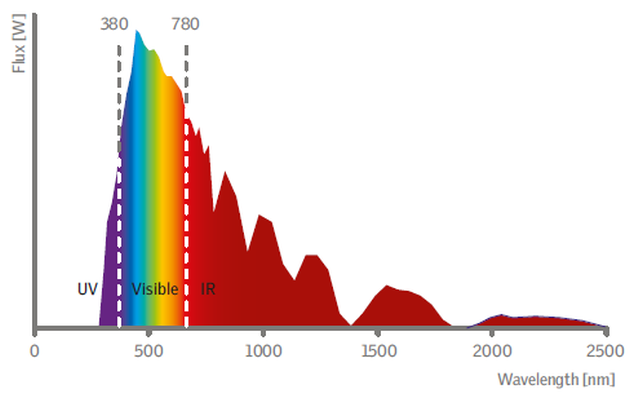
By Deborah Burnett, ASID, CMG, LGC, AASM – BENYA BURNETT CONSULTANCY, USA
Recent media reports have cautioned against the use of blue-rich white light sources at night such as iPhones, tablets, computers and bright LEDs lightbulbs at night. To better understand the concern and discover how any bright light at night impacts your health you must first comprehend how the brain and body use ambient light to derive important signals which ensure not only our health but our very survival.
Light is more than just a natural phenomenon which brighteners our day, warms our bodies and cloaks our evenings in darkness; it’s a vital component of life itself for all living beings. As humans, we perceive the daylight skydome as blue while the actual sunlight appears a bluish white light. Both sources of light enable us to visualize color via the three photoreceptors located at the back of the eye. The brain however receives the skydome light and sunlight and all other reflected light as measurable wavelengths of energy bands in order to be processed by both the visual system and the more important circadian system. Both systems use the eye as the primary input receiver for conveying the wavelength signals to the various brain structures and regions charged with providing for not only our sight, but all of our human biological, physiological and emotional needs. While the photoreceptors, cones and rods are receptive devices for vision, specialized cells in front of the photoreceptors collect light information for the circadian system. The collected information is filtered by wavelength or color of light as each travels at different speeds and feature varying strengths or amplitudes. Each of the 7 primary color bands comprised of numerous individual nanometre sized wavelengths impacts the human body and brain in ways that we are just now starting to fully comprehend.
For most folks, a good rule to consider is that the purple and blue wavelength bands of light travel the fastest and are the most intense as their amplitude or strength and are the most powerful. These bands widths are currently now under investigation by numerous labs worldwide and the initial evidence emerging is that if used correctly these bands have the potential to deliver untold beneficial health impacts. If used incorrectly or out of timing sequence however these are the most troubling as they have now been linked to increased health risks especially for the following conditions: breast cancer, ovarian cancer, macular degeneration, diabetes, heart conditions, metabolic syndrome, and depression.
The reddish wavelengths are the longest and travel more slowly delivering a more sustained and lower level of energy. These bandwidths are necessary for blood pressure regulation, expression of specific circadian genes, and the transition between the sleep process and the act of sleep. Both groups of wavelengths are vital for regulating and controlling such functions as blood pressure, heart rate, urine output, insulin production, hunger and satiation. Each of the primary wavelength bands ranging from 380 – 730 nm impact the body and brain in a reciprocitus fashion predicated upon a 24 period of predictable period of light and dark.
Blue-White Light ALERTS: dim RED light relaxes; and darkness is for SLEEP !
When the sun rises in the morning it is more than just a gorgeous sight- the angle of the rising dawn and gradual brightening color shift of light from darkness thru blue-based pinkish and full blown bright blue- based white light at noon impacts our biological clock; the primary control mechanism which governs our biological lives. The bright morning blue-based light is responsible for driving not only our daily alertness but also triggers expression of key genes which initiate neurotransmitters and other brain chemicals to function properly. We receive this light via specialized retinal cells which directly drive our biological clock. The retina cells are known as intrinsic Photosensitive Retinal Ganglion Cells; abbreviated as ipRGC. When specific bandwidths of blue-rich light strike the iPRGs during daylight hours, they send electrical information along a dedicated path to the master pacemaker called the suprachiasmatic nuclei ( SCN). This tiny group of cells is located in the brain near the optic nerve and sits atop an important brain structure which directly influences weight loss and gain, alertness, body temperature, and sleep. The morning or blue rich white light delivers a strong signal of speed and wavelength strength which initiates the iPRGC cells to deliver the signals which start or stop a predictable brain chemical cascade which wakes us up, keeps us alert and active during the day. If however we receive these same blue rich light signals at night, the same neurochemical response occurs and we are then negatively impaired and the result is a hampering of other bio-based functions such as the immune response, digestive process, and cell regeneration.
Scientific discovery is now demonstrating that bright blue- rich electric light also provides the same chronobiological signals as blue rich daylight. Although beneficial during the daylight hours, when delivered at night, the bright intense blue- rich white light such as delivered from any electronic device / computer, or glary LED streetlight, will negatively impact our health by delivering the same signals as if it were the morning hours thus supressing critical chemicals which are only active during darkness. And the reverse is also true in that not receiving ENOUGH blue rich bright light during daylight hours will also impact health by preventing us from expressing critical genes which ensure our very survival; in essence we are then living in a so called biological darkness where we are never fully awake or fully asleep: a state which delivers unwanted abdominal fat deposits, increased risks for breast cancer and lower immune function.
In this day and age of ever present light at night and an almost epidemic dependence upon blue rich bright light electronic devises, here are a few tips to lower your threshold for harmful negative biological impacts:
- Install a free download of a program called fLUX on every computer, phone and tablet. It automatically reduces the amount of blue white light emitted devices based upon an astronomical fix of your exact your latitude and seasonal light level fluctuations. In essence it changes the color of the backlighting from these devices from blue rich in the day to red rich in the evening hours thus lessening the dose of negative light you receive each day from artificial light sources. http://www.flux.com
- Only turn on overhead ceiling lights in the evening hours for emergency use only; until bedtime use low light level reading lamps, floor mounted uplights or wall directed lighting such as art and/or portrait lights which concentrate the light away from your eyes but still allow enough light to safely navigate your home in the semi-darkness.
- Consider purchasing specialized clear lens eyewear which block nighttime blue rich white light from entering the eye but still allow for ample color discrimination. I wear these eyeglasses at night while on the computer or watching TV because recent research has demonstrated that my risk of preventable macular degeneration is reduce by a whopping 25% ; a really good thing since my mother developed AMD at an early age and I’m prone for the same outcome. http://www.envisionmagazine.ca/meeting-the-blue-light-challenge/





